

Using Word Clouds in Q Ramlo Human Subjectivity 2011. Social media and professional development: a systematic review. * Abella, V.

& Delgado, V. (2015) ‘Aprender a usar Twitter y usar Twitter para aprender’, Profesorado, vol. 19, no. 1, pp. 364–378. Available at: Alshiekhly, U., et al., (2015) ‘Facebook as a learning environment for teaching medical emergencies in dental practice’, Education for Health, vol. 28, no. 3, pp. 176–180. Developing and Using a Codebook for the Analysis of Interview Data: An Example from a Professional Development Research Project. Interviewing As Qualitative Research A Guide for Researchers in Education And the Social Sciences ( PDFDrive ) Thematic Analysis: Striving to Meet the Trustworthiness Criteria - Lorelli S. Nowell, Jill M. Norris, Deborah E. White, Nancy J. Moules, 2017. What Is Already Known?
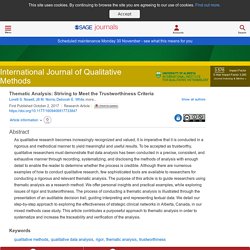
Adjust your own oxygen mask before helping those around you: an autoethnography of participatory research. 1.Israel B, Schulz A, Parker E, Becker A.
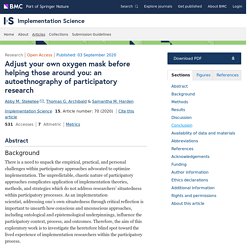
Community-based participatory research: policy recommendations for promoting a partnership approach in health research. Educ Heal. 2001;14(2):182–97.CAS Google Scholar 2.Bodison SC, Sankaré I, Anaya H, Booker-Vaughns J, Miller A, Williams P, et al. Engaging the community in the dissemination, implementation and improvement of health-related research. Clin Transl Sci. 2015;8(6):814–9.PubMed PubMed Central Google Scholar 3.Livingood WC, Bilello LA, Choe U, Lukens-Bull K. Enhancing the science of discovery in public health systems and services research through participatory research methods. 2017.01.04 Daniel and David January 4 Wednesday 2017 Final submitted (1) Laurence Anthony's Software. FireAnt (Filter, Identify, Report, and Export Analysis Toolkit) is a freeware social media and data analysis toolkit with built-in visualization tools including time-series, geo-position (map), and network (graph) plotting.

[FireAnt Homepage] [Screenshots] [Help] PayPal Donations and Patreon Supporters: Click one of the following if you want to make a small donation to support the future development of this tool. 07f2c146d39dd9cbd0297339aa1f9f6de8ca. "Examining the Potential of Combining the Methods of Grounded Theory an" by Shalini Lal, Melinda Suto et al.
Abstract Increasingly, qualitative researchers are combining methods, processes, and principles from two or more methodologies over the course of a research study.

Critics charge that researchers adopting combined approaches place too little attention on the historical, epistemological, and theoretical aspects of the research design. Rather than discounting eclecticism in qualitative research, we prefer to place it on a continuum of integration whereby at the ideal end of the spectrum, the researcher demonstrates thorough knowledge of the approaches being drawn from and a thoughtful consideration of the rationale for combining methods. However, there is limited reflection in the literature on the combination of methods from specific methodological approaches. Keywords. EJ978740. Grounded Theory: A Down-to-Earth Explanation – Research Methodology in Education.
Introduction & History Sociologists Barney G.

Glaser and the late Anselm L. Strauss developed grounded theory in the late 1960s. Following their study of terminally ill patients at the University of California San Francisco Medical Center, Glaser and Strauss recorded and published their methods of research. 07f2c146d39dd9cbd0297339aa1f9f6de8ca. How to conduct a qualitative meta-analysis: Tailoring methods to enhance methodological integrity: Psychotherapy Research: Vol 28, No 3. Although qualitative research has long been of interest in the field of psychology, meta-analyses of qualitative literatures (sometimes called meta-syntheses) are still quite rare.
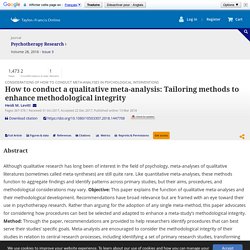
Like quantitative meta-analyses, these methods function to aggregate findings and identify patterns across primary studies, but their aims, procedures, and methodological considerations may vary. Objective: This paper explains the function of qualitative meta-analyses and their methodological development. Recommendations have broad relevance but are framed with an eye toward their use in psychotherapy research. Rather than arguing for the adoption of any single meta-method, this paper advocates for considering how procedures can best be selected and adapted to enhance a meta-study’s methodological integrity. Method: Through the paper, recommendations are provided to help researchers identify procedures that can best serve their studies’ specific goals.
Understanding the Different Types of Case Studies. 1.
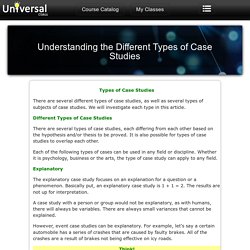
What is the background of the case study? Who requested the study to be done and why? What industry is the study in, and where will the study take place? 2. What is the problem that needs a solution? Public Books Database. With university classrooms and libraries shuttered because of the COVID-19 crisis, scholars are facing disruptions not only in their teaching lives but also in their ability to access research materials.
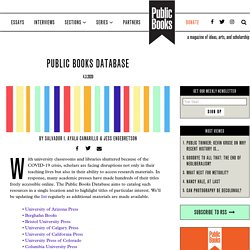
In response, many academic presses have made hundreds of their titles freely accessible online. The Public Books Database aims to catalog such resources in a single location and to highlight titles of particular interest. We’ll be updating the list regularly as additional materials are made available. • University of Arizona Press • Berghahn Books • Bristol University Press • University of Calgary Press. SAGE Reference - Posthumanism and Research in Digital Education. Normal Ethics Book Chapter WA PB GD Peer Review comments implemented 1. Where I call bullshit on the way we do the PhD – The Thesis Whisperer. There’s a looming economic crisis in higher education.
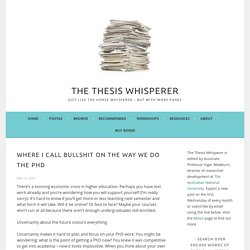
Perhaps you have lost work already and you’re wondering how you will support yourself (I’m really sorry). It’s hard to know if you’ll get more or less teaching next semester and what form it will take. Will it be online? Or face to face? Maybe your courses won’t run at all because there aren’t enough undergraduates still enrolled.
Uncertainty about the future colours everything. Uncertainty makes it hard to plan and focus on your PhD work. The combination of fear and uncertainty can make you feel a bit hopeless. Cambridge Core - Journals & Books Online. Skype as a Tool for Qualitative Research Interviews - Valeria Lo Iacono, Paul Symonds, David H.K. Brown, 2016. ECEL 2018 17th European Conference on e-Learning. EdTech Research: Ready For Your Next Conference? Consider Sketchnoting to Learn and Connect - AACE. Sketchnote that summarizes Don Norman’s book “Living with complexity” designed by Eva-Lotta Lamm in 2011.
Whether you are packing your bags to attend an edtech conference and looking forward to all the interesting meetings, talks and ideas the event will spark, or you are on your return journey and contemplating how to share what you learned with those back at work, consider using sketchnoting to create memorable conference summaries. Sketchnoting, sometimes also called graphic recording or visual notetaking, is a method of notetaking that incorporates hand-drawn visual elements. As Dimeo (2016) observed, sketchnoting has become an increasingly popular technique for recording information from meetings and presentations at conferences.
Mendonça (2016) even uses the term ‘Doodle Revolution’. Full article: Pragmatic meta-analytic studies: learning the lessons from naturalistic evaluations of multiple cases. Trial Sequential Analysis in systematic reviews with meta-analysis. We have explained and shown how the use of TSA may assist the meta-analyst in controlling risks of type I and type II errors when conducting meta-analyses. The use of TSA has now increasingly been advocated by authors, both inside and outside The Cochrane Collaboration [47, 60, 61]. However, the use of TSA is not easy, may be misused, and has been critisised [62]. If TSA is designed and conducted after data were collected, there is a danger that the analysis becomes data driven and that it may not be sufficiently stringent to address a predefined alternative hypothesis [63–65]. However, using data-driven hypotheses and analyses is a critique that could potentially be directed against all meta-analyses.
TSA has been criticised for transferring a method from a decision theoretical universe in a single randomised clinical trial into a universe where the result does not directly impact the subsequent decisions [63–66]. The Handbook of Research Synthesis and Meta-Analysis. View of Learning from the early adopters: developing the Digital Practitioner. (2) Conducting a Systematic Literature Review. 10.1.1. 0902 h. How to Get Published. Do you want to learn more about how to get published? Let us guide you through the process with our three new videos, 'Choosing a journal', 'Submitting your article' and 'Promoting your paper'. Video Resources Choosing a journal Looking to get your research published, but not sure where to start? Standards are high and getting published is not easy, but there are certain things you can do to improve your success rate. Submitting your article After you have thoroughly reviewed and finalized your work, you're ready to share your research paper with your peers in the academic community.
Promoting your paper The academic world is wide open for new, insightful research like yours, but it's also crowded. How to get published guide Download our guide to getting an article published in a SAGE journal. SAGE Research Methods: Find resources to answer your research methods and statistics questions. Pecha Kucha 20x20: Discover Pecha Kucha presentations, stories, ideas, examples, and videos that will inspire. Evidence-Based Reform in Education: Journal of Education for Students Placed at Risk (JESPAR): Vol 22, No 3. Thematic Coding and Categorizing - SAGE Research Methods. Creswell Qualitative Inquiry 2nd edition. Social Surveys. Part 1 of 2 on Surveys and Sampling.
Semi-Structured Interview - SAGE Research Methods.